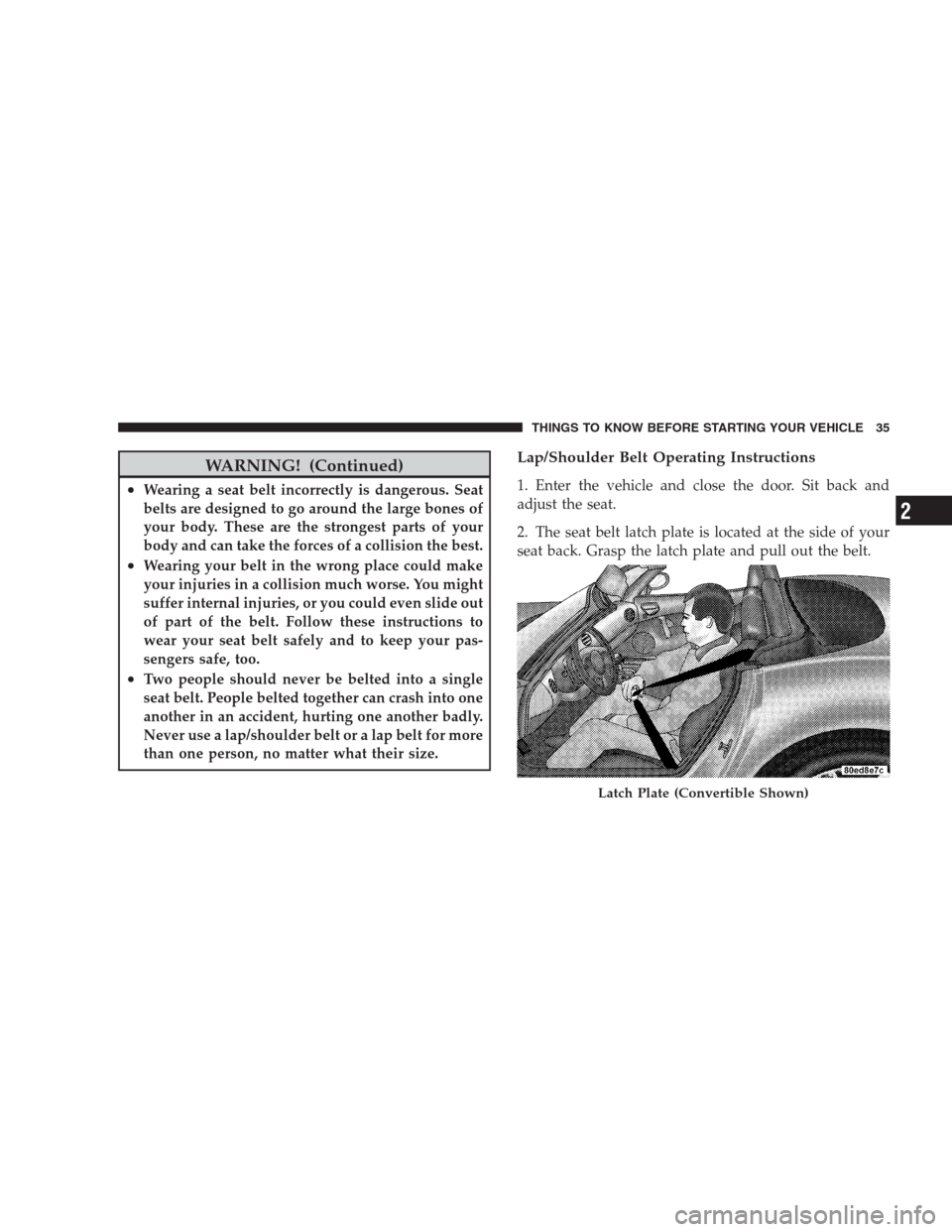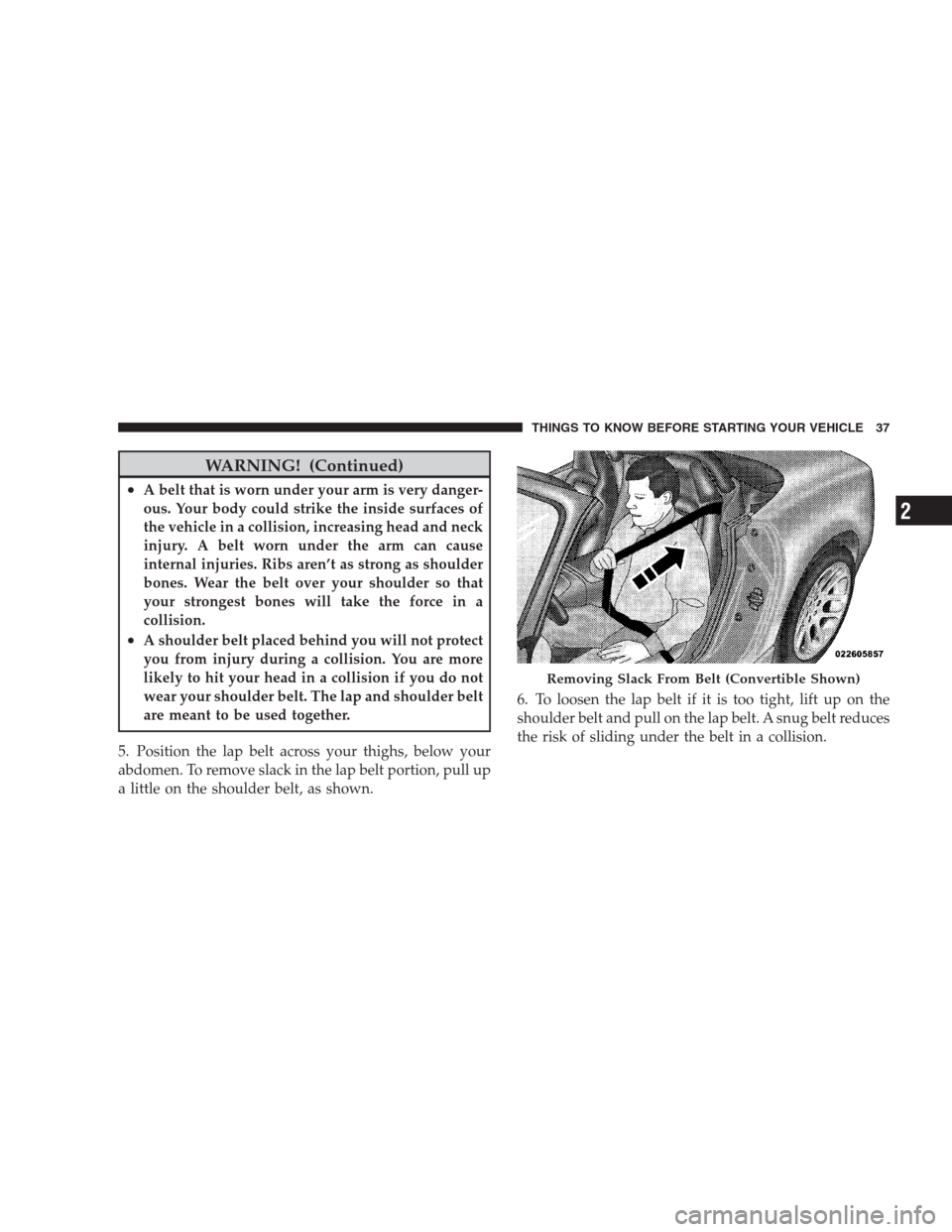Page 12 of 299

�Door Locks........................... 25
▫Manual Door Lock..................... 26
▫Power Door Locks..................... 26
�Windows............................. 28
▫Power Windows...................... 28
▫Auto Down Feature.................... 30
▫Wind Buffeting....................... 30
�Liftgate — Coupe Models Only............. 30
�Trunk Lock And Release — Convertible Models
Only................................. 32
�Trunk Safety Warning — Convertible Models
Only................................. 32
▫Trunk Emergency Release................ 33�Occupant Restraints..................... 33
▫Lap/Shoulder Belts.................... 34
▫Lap/Shoulder Belt Untwisting Procedure..... 39
▫Enhanced Seat Belt Reminder System
(BeltAlert�).......................... 39
▫Automatic Locking Mode................ 40
▫Seat Belts And Pregnant Women........... 41
▫Seat Belt Extender..................... 41
▫Driver And Passenger Supplemental
Restraint System (SRS) - Airbag............ 42
▫Child Restraint....................... 53
�Break-In Recommendations................ 59
10 THINGS TO KNOW BEFORE STARTING YOUR VEHICLE
Page 35 of 299

Trunk Emergency Release
The trunk of your vehicle is equipped with an emergency
release handle. It is located on the inside of the trunk lid,
near the latch, and is coated so that it glows in a darkened
trunk. Pull on the handle to open the trunk.
OCCUPANT RESTRAINTS
Some of the most important safety features in your
vehicle are the restraint systems. These include the seat
belts and the airbags for the driver and passenger.
Please pay close attention to the information in this
section. It explains how to use your restraint system
properly to keep you and your passenger as safe as
possible. Note that all of the warnings in this section
apply no matter which system you have.
WARNING!
In a collision, you and your passenger can suffer
much greater injuries if you are not buckled up
properly. You can strike the interior of your vehicle or
your passenger, or you can be thrown out of the
vehicle. Always be sure you and your passenger are
buckled up properly.
Emergency Release
THINGS TO KNOW BEFORE STARTING YOUR VEHICLE 33
2
Page 36 of 299

Buckle up even though you are an excellent driver, even
on short trips. Someone on the road may be a poor driver
and cause a collision that includes you. This can happen
far away from home or on your street.
Research has shown that seat belts save lives. They also
can reduce the seriousness of injuries in a collision. Some
of the worst injuries happen when people are thrown
from the vehicle. Seat belts reduce the possibility of
ejection and the risk of injury caused by striking the
inside of the vehicle.Everyonein a motor vehicle should
be belted at all times.
Lap/Shoulder Belts
Each seat belt is a combined lap/shoulder belt system.
The belt webbing retractor will lock only during very
sudden stops or impacts. This feature allows the shoulder
portion of the belt to move freely with you under normalconditions. However, in a collision, the belt will lock and
reduce your risk of striking the inside of the vehicle or
being thrown out of the vehicle.
WARNING!
•It is extremely dangerous to ride in a cargo area,
inside or outside of a vehicle. In a collision, people
riding in these areas are more likely to be seri-
ously injured or killed.
•Do not allow people to ride in any area of your
vehicle that is not equipped with seats and seat
belts.
•Be sure everyone in your vehicle is in a seat and
using a seat belt properly.
(Continued)
34 THINGS TO KNOW BEFORE STARTING YOUR VEHICLE
Page 37 of 299

WARNING! (Continued)
•Wearing a seat belt incorrectly is dangerous. Seat
belts are designed to go around the large bones of
your body. These are the strongest parts of your
body and can take the forces of a collision the best.
•Wearing your belt in the wrong place could make
your injuries in a collision much worse. You might
suffer internal injuries, or you could even slide out
of part of the belt. Follow these instructions to
wear your seat belt safely and to keep your pas-
sengers safe, too.
•Two people should never be belted into a single
seat belt. People belted together can crash into one
another in an accident, hurting one another badly.
Never use a lap/shoulder belt or a lap belt for more
than one person, no matter what their size.
Lap/Shoulder Belt Operating Instructions
1. Enter the vehicle and close the door. Sit back and
adjust the seat.
2. The seat belt latch plate is located at the side of your
seat back. Grasp the latch plate and pull out the belt.
Latch Plate (Convertible Shown)
THINGS TO KNOW BEFORE STARTING YOUR VEHICLE 35
2
Page 38 of 299
3. Slide the latch plate up the webbing as far as necessary
to make the belt go around your lap.
4. When the belt is long enough to fit, insert the latch
plate into the buckle until you hear a “click.”WARNING!
•A belt that is buckled into the wrong buckle will
not protect you properly. The lap portion could
ride too high on your body, possibly causing
internal injuries. Always buckle your belt into the
buckle nearest you.
•A belt that is too loose will not protect you as well.
In a sudden stop, you could move too far forward,
increasing the possibility of injury. Wear your seat
belt snugly.
(Continued)
Latch Plate To Buckle (Convertible Shown)
36 THINGS TO KNOW BEFORE STARTING YOUR VEHICLE
Page 39 of 299

WARNING! (Continued)
•A belt that is worn under your arm is very danger-
ous. Your body could strike the inside surfaces of
the vehicle in a collision, increasing head and neck
injury. A belt worn under the arm can cause
internal injuries. Ribs aren’t as strong as shoulder
bones. Wear the belt over your shoulder so that
your strongest bones will take the force in a
collision.
•A shoulder belt placed behind you will not protect
you from injury during a collision. You are more
likely to hit your head in a collision if you do not
wear your shoulder belt. The lap and shoulder belt
are meant to be used together.
5. Position the lap belt across your thighs, below your
abdomen. To remove slack in the lap belt portion, pull up
a little on the shoulder belt, as shown.6. To loosen the lap belt if it is too tight, lift up on the
shoulder belt and pull on the lap belt. A snug belt reduces
the risk of sliding under the belt in a collision.
Removing Slack From Belt (Convertible Shown)
THINGS TO KNOW BEFORE STARTING YOUR VEHICLE 37
2
Page 40 of 299

WARNING!
•A lap belt worn too high can increase the risk of
internal injury in a collision. The belt forces won’t
be at the strong hip and pelvic bones, but across
your abdomen. Always wear the lap belt as low as
possible and keep it snug.
•A twisted belt can’t do its job as well. In a
collision, it could even cut into you. Be sure the
belt is straight. If you can’t straighten a belt in
your vehicle, take it to an authorized dealer and
have it fixed.
7. Position the shoulder belt on your chest so that it is
comfortable and not resting on your neck. The retractor
will withdraw any slack in the belt.8. To release the belt, push the red button in the buckle.
The belt will retract automatically to its stowed position.
If necessary, slide the latch plate down the webbing to
allow it to retract fully.
WARNING!
A frayed or torn belt could rip apart in a collision and
leave you with no protection. Inspect the belt system
periodically, checking for cuts, frays, or loose parts.
Damaged parts must be replaced immediately. Do
not disassemble or modify the system. Seat belt
assemblies must be replaced after a collision if they
have been damaged (bent retractor, torn webbing,
etc.).
38 THINGS TO KNOW BEFORE STARTING YOUR VEHICLE
Page 41 of 299

Lap/Shoulder Belt Untwisting Procedure
Use the following procedure to untwist a twisted lap/
shoulder belt.
1. Position the latch plate as close as possible to the
anchor point.
2. At about 6 to 12 in (15 to 30 cm) above the latch plate,
grasp and twist the belt webbing 180 degrees to create a
fold that begins immediately above the latch plate.
3. Slide the latch plate upward over the folded webbing.
The folded webbing must enter the slot at the top of the
latch plate.
4. Continue to slide the latch plate up until it clears the
folded webbing.
Enhanced Seat Belt Reminder System (BeltAlert�)
If the driver does not buckle their seat belt and vehicle
speed exceeds 5 mph (8 km/h), or if the passenger does
not buckle their seat belt within 10 seconds of vehiclespeed exceeding 5 mph (8 km/h), the Enhanced Warning
System (BeltAlert�) will alert the occupant(s) to buckle
their seat belt(s). Once triggered, BeltAlert�will flash the
Seat Belt Reminder Light and chime for up to 96 seconds
to alert the occupant(s) to buckle their seat belt(s). If the
driver unbuckles their seat belt while vehicle speed is
greater than 5 mph (8 km/h), or if the passenger unbuck-
les their seat belt for more than 10 seconds while vehicle
speed is greater than 5 mph (8 km/h), BeltAlert�will
reactivate.
BeltAlert�Programming
BeltAlert�can be enabled or disabled by your authorized
dealer or by performing the following steps:
NOTE:Chrysler LLC does not recommend deactivating
BeltAlert�.
1. Close all doors.
2. Turn the ignition switch to the OFF/LOCK position.
THINGS TO KNOW BEFORE STARTING YOUR VEHICLE 39
2